A freshly-plumaged LeConte's Sparrow, Ammodramus leconteii, that Dave Rintoul banded in Kansas in the fall of 2005. (bigger version).
Image: Dave Rintoul, KSU.
Birds in Science
In the past few years, China has become famous for the number and quality of bird fossils from the Early Cretaceous that have been discovered there. This week, another such discovery has been reported by an international team of Chinese, American and Japanese scientists. Their discovery of 120-million-year-old fossilized footprints made by a roadrunner-like bird in Shandong Province, China (see map), was published in the European journal, Naturwissenschaften.
People Hurting Birds
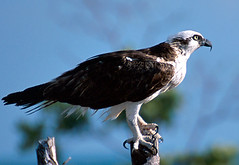 The owner of a Sunderland trout hatchery pleaded guilty to killing osprey, Pandion haliaetus (pictured, image: Birding.in), and herons that he found feeding at his fish pools in a Springfield, Massachusetts court. The owner of the Mojawk Trout Hatchery, Michael Zak, pleaded guilty to one count of conspiracy and two counts of violating the Migratory Bird Treaty Act. Zak, who is 59, was charged with two other charges, one of which is for allegations of shooting and killing a bald eagle. If convicted of all charges Zak could face up to three years in prison.
The owner of a Sunderland trout hatchery pleaded guilty to killing osprey, Pandion haliaetus (pictured, image: Birding.in), and herons that he found feeding at his fish pools in a Springfield, Massachusetts court. The owner of the Mojawk Trout Hatchery, Michael Zak, pleaded guilty to one count of conspiracy and two counts of violating the Migratory Bird Treaty Act. Zak, who is 59, was charged with two other charges, one of which is for allegations of shooting and killing a bald eagle. If convicted of all charges Zak could face up to three years in prison.
People Helping Birds
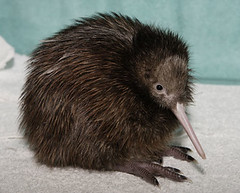 An Okarito kiwi chick, Apteryx mantelli (pictured, image: National Geographic), named Norbit was transferred from the Willowbank Wildlife Reserve in New Zealand to a predator-free island in the Marlborough Sounds yesterday. Department of Conservation (DOC) spokesman Duncan Kay said the chick was given the name Norbit because it was initially clumsy and "seemed like a bit of a Norbit".
An Okarito kiwi chick, Apteryx mantelli (pictured, image: National Geographic), named Norbit was transferred from the Willowbank Wildlife Reserve in New Zealand to a predator-free island in the Marlborough Sounds yesterday. Department of Conservation (DOC) spokesman Duncan Kay said the chick was given the name Norbit because it was initially clumsy and "seemed like a bit of a Norbit".
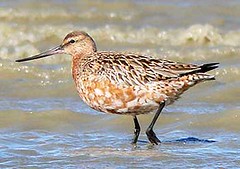 As the last bar-tailed godwits, Limosa lapponica (pictured), leave New Zealand estuaries on their northern migration to Alaska this week, Massey (New Zealand) scientists will trace their journey via satellite-tagged individuals. Phil Battley, an ecologist at the University's Palmerston North campus, says the shorebirds' northern migration is of particular interest because the birds touch down in Asia and are potential carriers of the H5N1 bird-flu virus to the Alaskan region. He says four birds have recently landed in the Yellow Sea, all covering more than 10,000 kilometers in six and a half to seven and a half days. "They fly in reasonably small flocks of 30 to 70 birds, and if one has touched down somewhere it is probable that a flock has landed."
As the last bar-tailed godwits, Limosa lapponica (pictured), leave New Zealand estuaries on their northern migration to Alaska this week, Massey (New Zealand) scientists will trace their journey via satellite-tagged individuals. Phil Battley, an ecologist at the University's Palmerston North campus, says the shorebirds' northern migration is of particular interest because the birds touch down in Asia and are potential carriers of the H5N1 bird-flu virus to the Alaskan region. He says four birds have recently landed in the Yellow Sea, all covering more than 10,000 kilometers in six and a half to seven and a half days. "They fly in reasonably small flocks of 30 to 70 birds, and if one has touched down somewhere it is probable that a flock has landed."
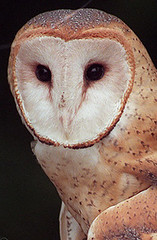 Pioneering research at the University of York will come to the rescue of barn owls, Tyto alba (pictured, image: Illinois Raptor Center), whose population has plummeted in the last 75 years. "We combined information gathered by volunteers with modern mapping techniques to help identify the best areas for barn owl habitat creation, and nest boxes," said Nick Askew, of the university's Department of Biology. "At present, there are only 4,000 pairs in Britain and more conservation effort is needed. Our results will allow conservationists to assess the suitability of their local area for barn owls, and make more informed decisions on how to help the species."
Pioneering research at the University of York will come to the rescue of barn owls, Tyto alba (pictured, image: Illinois Raptor Center), whose population has plummeted in the last 75 years. "We combined information gathered by volunteers with modern mapping techniques to help identify the best areas for barn owl habitat creation, and nest boxes," said Nick Askew, of the university's Department of Biology. "At present, there are only 4,000 pairs in Britain and more conservation effort is needed. Our results will allow conservationists to assess the suitability of their local area for barn owls, and make more informed decisions on how to help the species."
Echuya Central Forest Reserve in southwest Uganda, an Important Bird Area (IBA), will benefit from improved agricultural practices by local farmers who have been trained in sustainable organic agriculture techniques by an initiative coordinated by two BirdLife Partners. "For Echuya IBA to be conserved, we have moved the focus from the forests to the farm; improving the economic yield of farming practices in nearby communities as a means to reduce the environmental pressures bearing down on Echuya," said Ambrose Mugisha, Deputy-Director of NatureUganda.
A major UN conference on global warming in December should target setting up a system to pay developing nations such as Indonesia and Brazil to keep their forests, an influential climate change expert said on Friday. In the short term, up to US$15 billion extra a year should be set aside by richer nations to preserve forests, which help soak up carbon dioxide from the atmosphere, Nicholas Stern, author of an acclaimed report published last year, told a forum.
Rare Birds News
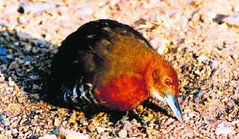 Naturalists have been gladdened by the recent sighting of Southern Ruddy Crake, Porzana pusilla (pictured), a bird that was last seen on the northern fringes of the city of Chennai, India around 20 years ago. Avid bird watcher V. Guruswamy said: "Southern Ruddy Crake belongs to the family of rails such as waterhen, purple moorhen, coot and Kora. Very little is known about its habitat. Unlike the waterhen or the purple moorhen, it does not come out of its cover frequently."
Naturalists have been gladdened by the recent sighting of Southern Ruddy Crake, Porzana pusilla (pictured), a bird that was last seen on the northern fringes of the city of Chennai, India around 20 years ago. Avid bird watcher V. Guruswamy said: "Southern Ruddy Crake belongs to the family of rails such as waterhen, purple moorhen, coot and Kora. Very little is known about its habitat. Unlike the waterhen or the purple moorhen, it does not come out of its cover frequently."
Researchers discovered a second Large-billed Reed Warbler, Acrocephalus orinus. The bird was thought to be extinct for 139 years. The sighting of the second Large-billed was sighted during the wastewater treatment experimentation at the royally initiated Laem Phak Bia Environmental Research and Development Project in Phetchaburi. On March 27th 2006, ornithologist Philip Round, the Assistant Professor of the Department of Biology in Mahidol University, was bird banding/ringing at a wastewater treatment centre and later discovered the bird as more than 500,000 birds of about 200 species have migrated to Thailand each year.
 Nest predation by snakes -a particular concern for several endangered parrot species- may be reduced by removing vines from the nest tree, and isolating its canopy from neighbouring trees. In a review of the results of two field studies, the authors examine the causes of nest failure of Black-billed Amazon, Amazona agilis (pictured), in Jamaica, and habitat use by Puerto Rican Boas Epicrates inornatus in Puerto Rico. Of 63 nesting attempts by Black-billed Amazons in the study, 35 (56%) failed before fledging at least one chick. Predation of nestlings accounted for over one-third of total nest failures.
Nest predation by snakes -a particular concern for several endangered parrot species- may be reduced by removing vines from the nest tree, and isolating its canopy from neighbouring trees. In a review of the results of two field studies, the authors examine the causes of nest failure of Black-billed Amazon, Amazona agilis (pictured), in Jamaica, and habitat use by Puerto Rican Boas Epicrates inornatus in Puerto Rico. Of 63 nesting attempts by Black-billed Amazons in the study, 35 (56%) failed before fledging at least one chick. Predation of nestlings accounted for over one-third of total nest failures.
Birding News
One of Africa's most established and celebrated ecotourism initiatives, the Zululand Birding Route, celebrated its 10th anniversary this previous weekend. "It has been a real conservation success story. To see the Zululand Birding Route reach 10 years is testament to how simple and effective the avitourism [birding ecotourism] concept has been in this case," said Duncan Pritchard, BirdLife South Africa Avitourism Division Manager. "There have been winners all round: local economies, jobs, education and, of course, the birds."
In just four days in February, participants in the Great Backyard Bird Count tallied more than 11 million birds across the U.S. and Canada. Together, they recorded 616 species and submitted more than 80,000 checklists -- 33 percent more than the previous high of 61,000 checklists in 2000. The GBBC, a joint project of the Cornell Lab of Ornithology and National Audubon Society, engages people of all ages and levels of experience in learning about birds and reporting their sightings for conservation. Robins topped the list as the most numerous species counted, with more than 2 million robins reported from 60 states and provinces.
 The RSPB's 2007 Big Garden Birdwatch results from the UK show smaller numbers of several songbirds in gardens, most notably those whose winter numbers are usually swelled by seasonal migrants from the continent. In gardens in Northamptonshire, the house sparrow was the most common bird with an average of 4.7 visits per hour. Starlings came second with an average of 3.5 visits and blue tits third with 2.7. "A snapshot in winter gives only part of the picture, but the varying birds visiting our gardens is one example of the impact climate change is having on the natural world," said Ruth Davis, the RSPB's head of climate change policy. [more news about the UK Garden BirdWatch]
The RSPB's 2007 Big Garden Birdwatch results from the UK show smaller numbers of several songbirds in gardens, most notably those whose winter numbers are usually swelled by seasonal migrants from the continent. In gardens in Northamptonshire, the house sparrow was the most common bird with an average of 4.7 visits per hour. Starlings came second with an average of 3.5 visits and blue tits third with 2.7. "A snapshot in winter gives only part of the picture, but the varying birds visiting our gardens is one example of the impact climate change is having on the natural world," said Ruth Davis, the RSPB's head of climate change policy. [more news about the UK Garden BirdWatch]
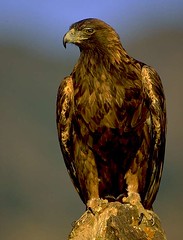 For the first time in Scotland one of the country's most enthralling wildlife spectacles is to be included as the centerpiece of an exciting new visitor attraction, which opens to the public on Sunday April 1, 2007. The unprecedented venture will allow nature enthusiasts to get up close and personal with golden eagles, Aquila chrysaetos, in their natural habitat among the inspiring craggy glens of Scotland's wild west coast. At the time, Culture Minister Patricia Ferguson said that she was concerned that visitors to Scotland might be under the impression they would be guaranteed to see a golden eagle. Unfortunately that can't be guaranteed even with this new project, but this certainly is the best chance people have of seeing one up close, in its natural habitat, and hopefully will provide a major tourism boost to the area as its reputation spreads.
For the first time in Scotland one of the country's most enthralling wildlife spectacles is to be included as the centerpiece of an exciting new visitor attraction, which opens to the public on Sunday April 1, 2007. The unprecedented venture will allow nature enthusiasts to get up close and personal with golden eagles, Aquila chrysaetos, in their natural habitat among the inspiring craggy glens of Scotland's wild west coast. At the time, Culture Minister Patricia Ferguson said that she was concerned that visitors to Scotland might be under the impression they would be guaranteed to see a golden eagle. Unfortunately that can't be guaranteed even with this new project, but this certainly is the best chance people have of seeing one up close, in its natural habitat, and hopefully will provide a major tourism boost to the area as its reputation spreads.
Avian Influenza News
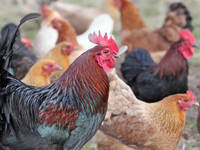 A comprehensive critical review of recent scientific literature on the spread of Highly Pathogenic Avian Influenza H5N1, published in the British Ornithologists Union journal, Ibis, concludes that poultry trade, rather than bird migration, is the main mechanism of global dispersal of the virus. The review article finds that migratory birds have been widely and repeatedly blamed for outbreaks that have subsequently been found to originate in the movement of live poultry and products such as poultry meat.
A comprehensive critical review of recent scientific literature on the spread of Highly Pathogenic Avian Influenza H5N1, published in the British Ornithologists Union journal, Ibis, concludes that poultry trade, rather than bird migration, is the main mechanism of global dispersal of the virus. The review article finds that migratory birds have been widely and repeatedly blamed for outbreaks that have subsequently been found to originate in the movement of live poultry and products such as poultry meat.
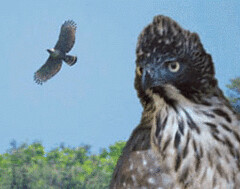 The deadly H5N1 strain of bird flu has been found in the body of an endangered eagle in southern Japan, the environment ministry said Sunday, according to reports. The ministry had tasked a laboratory at Tottori University with examining the female of the species, called the mountain hawk eagle, Spizaetus nipalensis (pictured, image: Mountain Hawk Eagle Society of Hiroshima), after it was found in the village of Sagara, in Kumamoto Prefecture, on January 4. The sick bird died shortly afterwards, according to the Kyodo news agency.
The deadly H5N1 strain of bird flu has been found in the body of an endangered eagle in southern Japan, the environment ministry said Sunday, according to reports. The ministry had tasked a laboratory at Tottori University with examining the female of the species, called the mountain hawk eagle, Spizaetus nipalensis (pictured, image: Mountain Hawk Eagle Society of Hiroshima), after it was found in the village of Sagara, in Kumamoto Prefecture, on January 4. The sick bird died shortly afterwards, according to the Kyodo news agency.
This week, human cases of the deadly H5N1 influenza have been reported in Egypt, China and possibly in Indonesia, and in domestic poultry in Bangladesh, Kuwait and Viet Nam.
Online Bird Publications
There is an excellent article on raven intelligence in the April issue of Scientific American available online. I plan to write a summary for you sometime this week, so be sure to check for that.
The American Birding Association has a new "Sightings" article available online for your reading pleasure [PDF].
Streaming Birds
 On BirdNote, for the week of April 2, 2007: Monday, the furious courtship of Rufous Hummingbirds, Selasphorous rufus; Tuesday, the leks of the Greater Prairie-Chicken, Tympanuchus cupido; Wednesday, more about the Wilson's Warbler, Wilsonia pusilla; Thursday, why raptors breed so early; Friday, "Bufflehead, Never Still". BirdNotes transport the listener out of the daily grind with two-minute vignettes that incorporate the rich sounds of birds provided by Cornell University and by other sound recordists, with photographs and written stories that illustrate the interesting -- and in some cases, truly amazing -- abilities of birds. Some of the shows are Pacific Northwest-oriented, but many are of general interest. BirdNote can be heard live, Monday through Friday, 8:58-9:00AM in Western Washington state and Southern British Columbia, Canada, on KPLU radio and now also in North Central Washington state on KOHO radio. All episodes are available in the BirdNote archives, both in written transcript and mp3 formats, along with photographs. Listener ideas and comments are welcomed. [rss].
On BirdNote, for the week of April 2, 2007: Monday, the furious courtship of Rufous Hummingbirds, Selasphorous rufus; Tuesday, the leks of the Greater Prairie-Chicken, Tympanuchus cupido; Wednesday, more about the Wilson's Warbler, Wilsonia pusilla; Thursday, why raptors breed so early; Friday, "Bufflehead, Never Still". BirdNotes transport the listener out of the daily grind with two-minute vignettes that incorporate the rich sounds of birds provided by Cornell University and by other sound recordists, with photographs and written stories that illustrate the interesting -- and in some cases, truly amazing -- abilities of birds. Some of the shows are Pacific Northwest-oriented, but many are of general interest. BirdNote can be heard live, Monday through Friday, 8:58-9:00AM in Western Washington state and Southern British Columbia, Canada, on KPLU radio and now also in North Central Washington state on KOHO radio. All episodes are available in the BirdNote archives, both in written transcript and mp3 formats, along with photographs. Listener ideas and comments are welcomed. [rss].
Miscellaneous Birds
A duck named peepers fouled up an attempted shoplifting in Lynnwood, Washington.
.
The Fine Print: Thanks to Biosparite, Albatrossity, Ian, Jeremy, Ron and Ellen for sending story links. Thanks in advance to Ian for catching my typos; as you probably know by now, I put a few typographical errors in these documents just so Ian can find them! Images are resized and are either linked from the news story that they accompany or they are credited and linked back to the photographer.
What is the point of Birds in the News? I publish BITN each week because I want to increase people's awareness of the importance of birds in our everyday lives. Birds represent many things to us; beauty, freedom, music, wildness. But everywhere, birds are coming under increasing pressure for their very survival, and by linking to news stories about birds, I hope to make the smallest impression upon the public and the mainstream media, as well as our decision-makers, that birds are an important feature of our everyday lives, that there are so many reasons that we could not do without them.
tags: Birds in the News, ornithology, birds, avian, newsletter

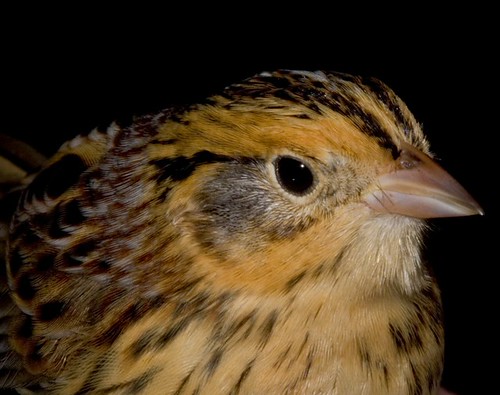

Not sure if it's news, but some people are still stupid. Like this guy who shot two blue herons. Didn't know what they were. Just shot 'em.
Glad you are able to make use of so many of the bird stories I send out every week to the various groups and lists! Nice job on the blog!
That parrot being squeezed by the snake. It's a good picture but... oh well, it's part of nature.
if i am not mistaken, that parrot chick was perched on the satiated snake after it squeezed two of its siblings. i have no idea if that last chick survived to fledge but it might have, since it looks close to fledging and the snake might have had enough to eat for a few weeks.
of course, this might be wishful thinking on my part, too.